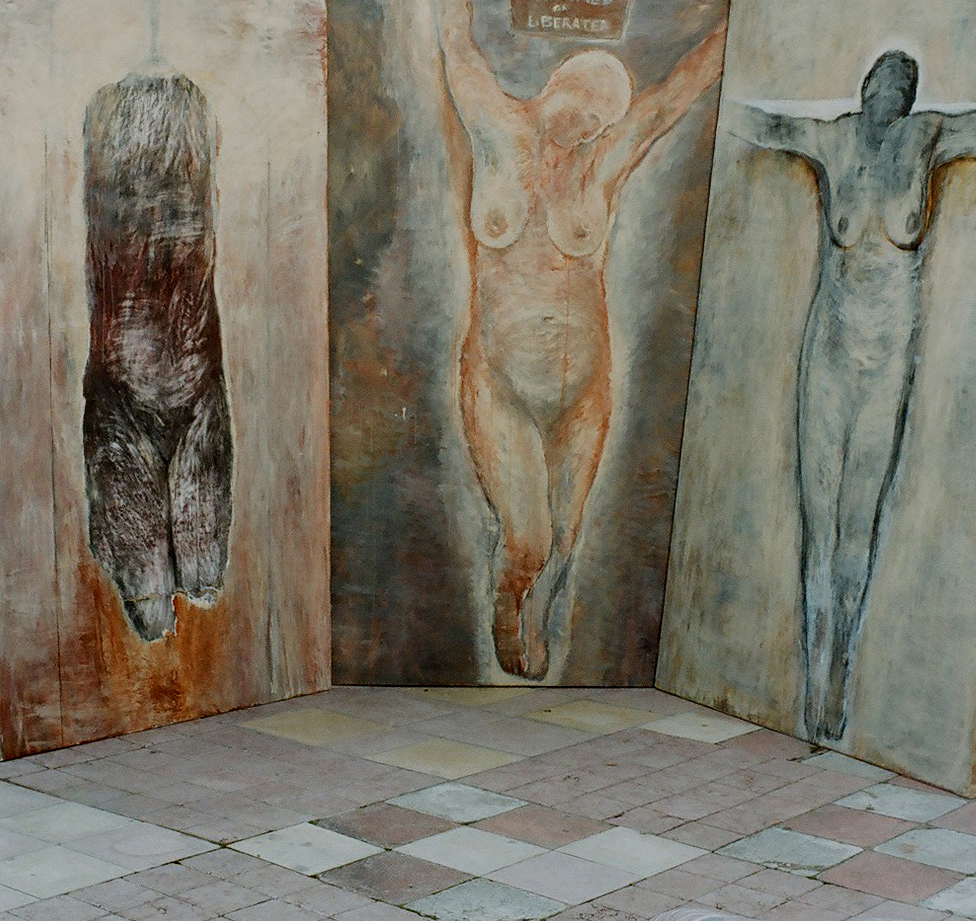Tryptich by Sophie Jungries
A few personal responses to the talks I attended at the “Crucified Woman Reborn” conference, Emmanuel College, May 14 and 15, 2010
Doris Jean Dyke was the opening keynote speaker at the conference. Doris was the first woman professor at Emmanuel College, and the author of the book, Crucified Woman. This book tells the story of how Almuth Lutkenhaus’ sculpture came to Emmanuel College, and the theological debates it set off.
In her viola-timbred voice, Doris gave a moving talk that included many examples of women associated with the cross, including an eye-opening reference to Hagar of the old testament, as one of the earliest examples of domestic abuse. Another reference that I found intriguing was to Chaim Potok’s novel, My Name is Asher Lev. Here the young orthodox Jewish artist paints his mother as crucified and captive, the very ground of the “war” between himself and his father. Asher, an observant Jew, created this painting of a crucifixion because, he says, “there was no aesthetic mold in his own religion into which he could pour a painting of ultimate anguish.”
Photojournalist Rita Leistner later took us through haunting, disturbing photographic images, some of them taken by her and some by other women photojournalists. These photos included images of abandoned mental patients and self-immolated child brides in Iraq, as well as images of Jewish women protesting their exclusion from prayer at the Western Wall in Jerusalem. I thought again about the many ways that women continue to be crucified in our world today.
I take comfort in looking back to the opening ceremony in the sculpture garden, with the wind moving the branches of the silver birches so that they formed a swaying shawl around Lutkenhaus’s statue. Marjory Noganosh and Dorothy Peters opened the conference and gave thanks for the many blessings we enjoy, symbolized by of a bowl of water and a bowl of red, heart-shaped berries. I realize, once again, that we are learning many lessons about living in peace, not just with each other, but with the entire cosmos, from the gentle teachings and wisdom of this country’s first people.
Second Day of the “Crucified Woman Reborn” conference, May 15, 2010
The dance in the garden – humor and satire; rhythm and colour. In the final act, a many coloured prayer shawl is placed on the shoulders of the lady statue.
Marjory’s opening talk: It’s not about throwing everything away from our own traditions – keep, safeguard what works. This resonated with Pat Capponi’s comments about her advice to her activist apprentices that they need not scrape the bottom of their emotional well of painful life experiences to find the resources for the activist work they are being trained to do on poverty and mental health issues. Just skim the surface of the deep well – that is enough. Measure and moderation as a response in the face of extreme need for social action – this is very interesting.
Sophie Jungreis: I note the very visceral nature of the paintings and the sculpture – like Rita’s photos, not pretty. Here we go into the deep recesses of the psyche to explore the roots of pain, and of healing. See Sophie’s reference to the lines in the blessings of Jacob to Joseph: (Gen. 49:25): “Blessing of the deep that couches beneath / blessings of the breast and of the womb.”

